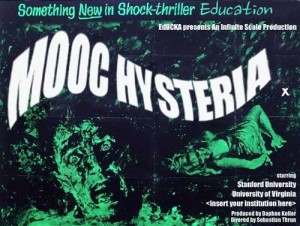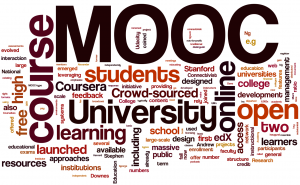What is the Media & Cultural Studies of the MOOC?
What can the media and cultural studies scholar contribute to the flurry of dialogue accumulating discursive authority as “The Year of the MOOC“?
MOOCs – massive open online courses – are loosely modeled on traditional college courses. The immediate differences are clear in the name – massive (high enrollment, dispersed geographically), open (articulated to free and accessible), and online (web-based facilitation, although for many online also signifies non-human and non-residential). MOOCs are mostly non-credit granting and mostly free. Weekly video lectures anchor courses, around which crowd-sourced homework and Blackboard-like forums orbit. Social media serves as digital TA. Most MOOCs are taught by faculty or instructors at traditional four-year universities worldwide. Three organizations – Coursera, Udacity, and edX – currently dominate the field. For an overview, The Chronicle of Higher Education offers “MOOC Madness,” while visual learners may prefer this mini-MOOC.
MOOCs are a hot button issue for educators, policy makers, technorati, and anyone invested in the state of formal education. Although histories of technology remind us that flux moments are always accompanied by “the discursive polarities of utopia and dystopia,” the future is a high stakes game. For some, the MOOC’s maximum visibility means that the democratization of education is within reach. For others, the MOOC undermines the deeply rooted epistemologies of the traditional university and forces higher ed administrators to address outdated teaching models. Still for others, the MOOC reflects disordered priorities that ignore inequality.
As Siva Vaidhyanathan warns, declaring the MOOC the deus ex machina of the ills of education or the ultimate threat to the university is an effort that obscures the more productive strategies of critical observation. The MOOC is a fruitful object of study if we ask the right questions. Continuing the long road, then, that stretches back to the Birmingham School’s commitment to non-traditional students and has drawn continuously from an ever-shifting circuit of culture model, let’s approach “MOOC Madness” through the relational lenses of text, audience, and industry. What’s at stake in the consciousness of this moment, what are its historical precedents, and how is it inscribed with power?
We must begin by thinking of the MOOC as a medium and a mediated text. What are the defining properties of something being positioned as educational, massive, and open, and how are these properties re-presented in an online environment? What is the structured center (lecture model? network? visuality?) and its textual surround? What are the aesthetics of the MOOC’s online presence – entertaining? informative? What are the legitimating discourses of the MOOC – what is being offered to the enrollee and how is it staged as exceptional? How (and why) is the definition of massive, open, and online learning constricted? These are questions that can only be addressed through attention to the text itself.
At present, the best way to reach the MOOC audience is to return to the text. That is, how are potential enrollees being hailed by the MOOC and its paratexts – Coursera’s “About Us” page, for instance, or email notices from instructors? Traces of reception are emergent. Duke University’s summary report on its first MOOC suggests that people enroll “for fun,” while this blog chronicling a retired academic’s enrollment offers experiential insight. Meanwhile, CourseTalk.org has begun to aggregate student reviews of MOOC courses.
What is being offered, then, to whom and how is this offering received? Does someone taking “Introduction to Computational Finance” expect a different outcome than someone taking “The Ancient Greeks”? Do MOOC participants see themselves as students? How does the meaning of student change when enrollees know classmates from “tweet ups” and “virtual office hours,” when the line between crowd-sourced homework and plagiarism is unclear, and when time-shifting means one is less likely to cut out of a video lecture for a round of beer pong (perhaps one streams “Computational Finance” while playing beer pong)? What is the everyday reception of the MOOC and how is that everyday-ness altered by the structure, content and presentation of massive, open, online learning opportunities and a firmer sense of what motivates participation?
Attention to industry and production further complicates the meaning and materiality of the MOOC. Media are produced, with money, by people, through technology. On a more micro level, what is the industry that makes the MOOC visible? Who films the video lecture and alters instructional design? When media workers are asked what technological affordances facilitate learning objectives, they advise on the mediation of knowledge and become pedagogical theorists. How do these “best practices” of web-based facilitation become inscribed in the content of the MOOC and change the model and meaning of reception? From a produsage perspective, how do communities of interest alter the structure of a course?
The lens of production may also offer a nuanced corrective to the suggestion that once we get past the “big misunderstanding” of MOOCs – that is, once we understand that the MOOC isn’t the message – we can rest easy that this campus tsunami is non-threatening. This naive separation of technology-as-transmission from technology-as-meaning sounds familiar. The point is, the MOOC is presented to us fully formed. These questions of industrial practice, technological form, and media work muddle the definition of a massive, open, online learning experience through deconstruction and a focus on the processual.
Reviewing these questions, the messiness of my attempt to delineate text, audience, and industry reveals the value of integration as well as the value of research inquiries that cut across and in between: questions of address, mediation, and exclusion. What does the MOOC expose about the socio-cultural expectations of the Internet as a medium? What is the productive power, in a Foulcauldian sense, of delimiting definitions of massive, open online learning? And how might things like networked, casual audiences or media production decisions adjust the structured center of the MOOC? Indeed, what in the world is a MOOC? When we bend the MOOC to the questions we ask best, its significance as an artifact of media and cultural studies comes more clearly into focus.





